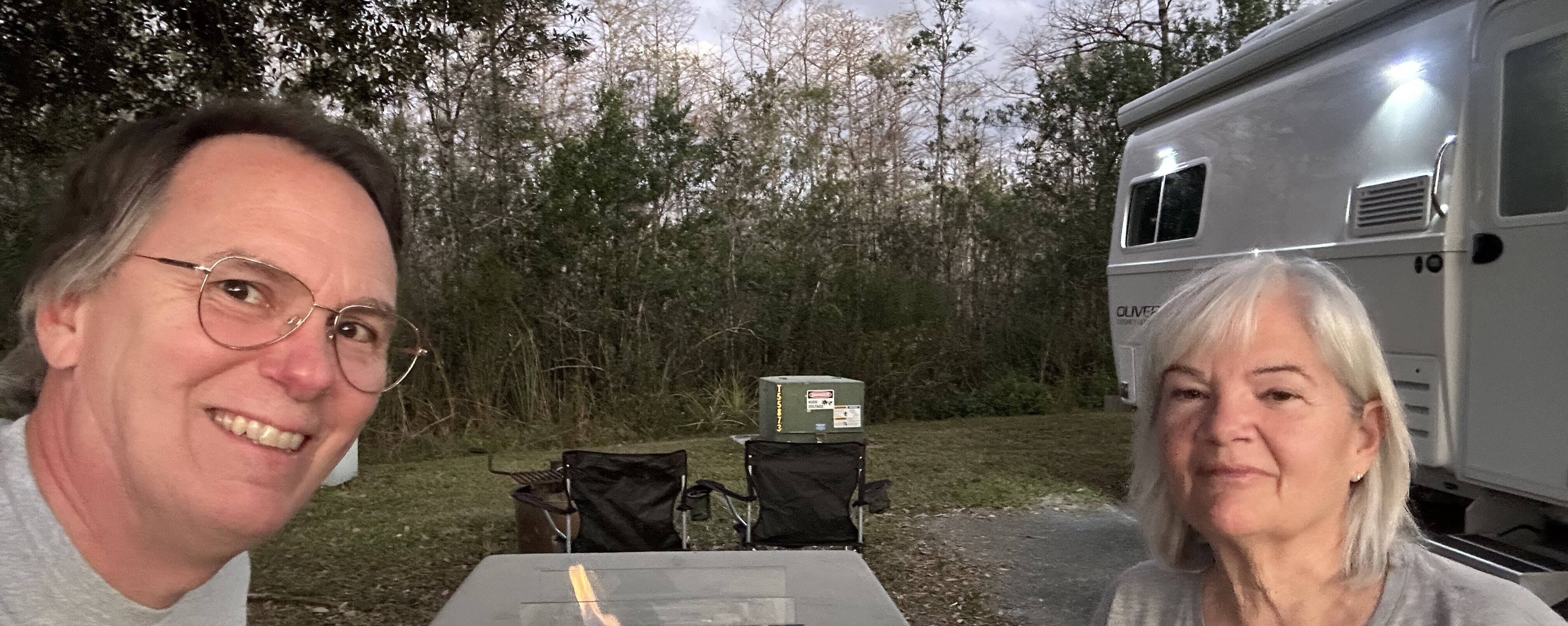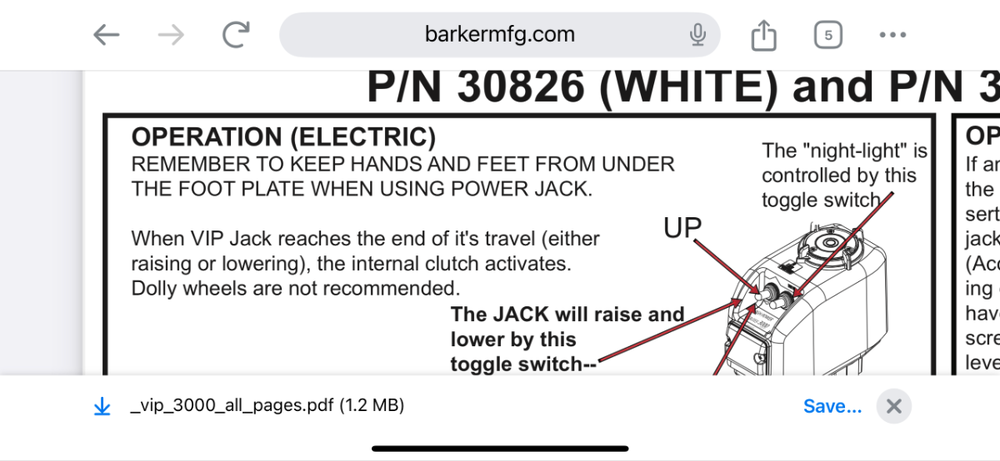
Galileo
Member+-
Posts
252 -
Joined
-
Last visited
-
Days Won
5
Everything posted by Galileo
-
HOW TO: VIP 3000 Electric Stabilizer Jack Service
Galileo replied to John E Davies's topic in Mechanical & Technical Tips
I’m afraid I have to agree with you here. Im often tempted to leave my car doors unlocked. Though I try not to leave valuable (looking) stuff in the car, I don’t want some clown breaking a window just to steal my knockoff sunglasses, or hack my $50 cd player out of the dash with a hatchet. (When I worked at the Buick dealer - I saw some pretty expensive damage just to steal a radio or break into a trunk to steal a spare tire!) -
Andersen WD Hitch Periodic Maintenance?
Galileo replied to Galileo's topic in Mechanical & Technical Tips
I admit that my go/no-go decision making as to whether I DIY it or take it to the dealer are a bit arbitrary. I think most it’s the “Are you f-ing kidding me!?” When they quote me the price. $900 to replace the blank tank dump valve triggered my DIY mode (my cost - ~$250) Pretty sure OTT quoted me about $4k to replace the noisy Penguin with the somewhat less noisy Truma A/C. Since you can buy a new unit from Amazon for under $1,500 delivered, that was a no-go. Last major automotive job I took on was inner tie rod ends in my old 2000 Ranger (with 300,000 miles) - they wanted $900. I could buy a whole rebuilt power rack & Pinion for $150. All I used the shop for was an alignment when I was done. Sometimes is strictly the $$$ amount. Sometimes it’s the temerity of the quote. -
Not one to enjoy TOO much adventure, I may just travel the path more heavily travelled.
-
If you will be good enough to forward the membership requirements, application, and schedule my entrance interview - I’d be obliged. (That is to say that I likely already have the experience and qualifications for membership - you’re just lucky enough not to have known me for very long. 😋 )
-
They may well be LP fueled now, but I’d wager that there are at least a few 70’s-80’s vintage Onan-equipped RVs out there that were gasoline powered. I suppose on a trailer, LP would be the obvious fuel. Motorhomes - the gas tank is -right- there….
-
While a marine “watermaker” certainly IS an R/O system, it’s more of a specialized system for making drinking water out of sea water. They’re quite expensive and overkill for most of our purposes. (We also have a sailboat and briefly considered a watermaker.) I just like bottled-water quality without the waste of all those plastic bottles going into the waste stream (then into the ocean, landfill, or into our bodies via microplastics) a conventional R/O system as one would install under their sink at home can be had for $150 or so these days. Conventional water filters (like Camco sells) are basically for particulates and maybe taste via a carbon filter. They won’t remove dissolved stuff in the water. These days, with industrial waste in the ground and agricultural runoff, you really have no idea what’s in your water supply and I prefer to ingest as little of the unknown chemicals as possible.
-
HOW TO: VIP 3000 Electric Stabilizer Jack Service
Galileo replied to John E Davies's topic in Mechanical & Technical Tips
I half-wondered why there wasn’t an easily accessed switch that would let the owner disable the front jack so that goofy people couldn’t come by our trailer and hack with it (ha ha) or turn that light if it whatever. Taking the fuse out would do that, but kind of a primitive “switch”. Probably a good mod for one of our owners who like to improve things. A simple toggle or rocker switch would do the trick. -
HOW TO: VIP 3000 Electric Stabilizer Jack Service Part 2
Galileo replied to dmtaylor2's topic in Mechanical & Technical Tips
I think JD and I have to agree to disagree on this point. IMHO there’s no reason to put grease anywhere except where it’s going to actually be doing anything. Where gear teeth mesh, on shafts and bores of bearing surfaces, and a film on gear faces that might be exposed to thrust loads. As JD says - grease does not “fling”. For that matter, unless it gets TOO hot, it’s unlikely to even flow. So “packing” grease on top of or between gears is unlikely to do anything for you. That’s why you see caked and solidified grease when you open the gearbox. I suppose that preventing air from contacting the gears -may- do something, but I side of a sealed (gasketed) gearbox, I doubt it’s a factor. I too spent more than a few years in automotive service and industrial maintenance. Getting the lube to exactly where it’s doing a job is important. Adding a bunch more grease is just good for the grease vendor…. -
Houghton Retrofit Process & Questions
Galileo replied to Geronimo John's topic in Mechanical & Technical Tips
Stihl 026 - the old numbering system. I wasn’t using chain saws back then. Bought the farm in 2008. (And sold it in 2021). My saws were all the “MS” numbering. The MS362C-M was my “big” saw. A pair of MS250’s and an older MS180CB were the everyday saws. Sure, when you open them up they scream. At idle, they purr. (That’s when the Dometic A/C would be louder!) -
HOW TO: VIP 3000 Electric Stabilizer Jack Service Part 2
Galileo replied to dmtaylor2's topic in Mechanical & Technical Tips
I don’t think it’s so much “tight” as it is some kind of galvanic corrosion from dissimilar metals. They basically “weld” themselves into place. Very true! In my stint in maintenance management, I learned a new term: “maintenance induced failure”. Whether that’s from improper maintenance procedures that cause damage (think AA191) or a situation like JD mentions above. If you’re not going to clean out ALL the dirt - including the dirt opening the gearbox likely introduces into the unit - then you’re mostly just going through the motions. -
Houghton Retrofit Process & Questions
Galileo replied to Geronimo John's topic in Mechanical & Technical Tips
Pretty sure I’ve measured the Dometic Penguin A/C at 70+ dB on LOW fan. To watch television, you have to have it at 90+ volume. Not good for one’s ears. For comparison, Honda 2200EUi generator is 58 Db…. Anyway, I think this horse is -thoroughly- dead. ”Dis-MOUNT!” (oh, and I think my Stihl MS362C-M is quieter FYI 😋 ) -
Unfortunately, I see these puppies are going for $549.00 these days. Ouch! Pretty sure we paid under $200 for ours. I don’t think I’d buy one for $550. That said, it’s still a very simple and clever device. With a few improvements, it could be even more versatile. I’ve had to do some repairs on ours. The wood frame didn’t appreciate being left out in the rain a couple of times. So I made a new one up out of birch plywood and finished it with marine varnish. Better than new!
-
The reflectors fold down against the glass. It’s about the same size as a clunky suitcase or French Horn case when folded. Has its own carry handle. Back in the bad old Facebook days, whenever Sun Oven International (the manufacturer) did a post, some wise-ass would say “Ha! You can build one of those with an old cardboard box and aluminum foil!”. Well, I guess you could - if you wanted a 7th grader’s science fair project to cook dinner with. Granted, this particular mfg and model are “no frills” - but that’s half the point. It’s designed to be something that people in developing countries can easily build. No custom castings or exotic materials. No complicate assembly procedures. Id actually like a nicer one - better reflectors, insulation, more robust leveling/aiming mechanism. So far, I’ve not found one. Still looking. Back on the farm, I also had a “solar Burner”. Basically a 6’ diameter, mylar-lined parabolic dish with a support for a frypan. It wasn’t terribly practical because of its size, but it was cool. Once aimed, you could light something on fire (or really burn your hand) just by holding it in the focus of that big reflector. Fun times!
-
Maybe a political protest? Though NO mechanical device is completely foolproof and inherently safe, I’d tend to trust Honda before some of the Harbor Freight fly-by-night brands out there. I had a no-name discount store open-frame generator for a season. It kept my freezers going during a week-long power outage, but I wouldn’t trust it as far as I could throw it. I suppose if one were gonna design and install a ventilation/cooling system in an enclosed box on the front of the Ollie, they may as well go whole-hawg and design a system that monitors CO, temperature, etc and shuts down the gen and triggers the fire suppression system if parameters were exceeded. I wonder if folks in motor homes with built-in Onan or Generac generators running -inside- the body of their RVs give it so much thought….
-
HOW TO: VIP 3000 Electric Stabilizer Jack Service Part 2
Galileo replied to dmtaylor2's topic in Mechanical & Technical Tips
The three set screws on our tongue jack removed themselves the first time. An entertaining experience if you’re not expecting it. (Head spins around.) I tightened them up after that. I suppose I’d better go back and apply the Never-Seize so that they ARE removable when the time comes. -
I didn’t know that the “recent” change to LP tanks (whatever you call that overfill prevention device - when the shape of the valve knobs changed, and propane places stopped rifling the I’d ones) did anything except prevent it from being filled to more that XX percent of full by volume to allow for expansion. I think the POL (“Press-to-lite”) coupler/valve is what did the shutoff if there’s too much flow. I could easily be wrong, but I remember even “old” tanks would shut off with high-flow devices. (I have a 140,000 BTU “King Kooker” burner that was good at this.)
-
Houghton Retrofit Process & Questions
Galileo replied to Geronimo John's topic in Mechanical & Technical Tips
I agree with you on steroids regarding the original Dometic “Penguin” A/C as far as noise and just plain silly operation. (On “auto” it’s positively schizophrenic with fan turning on and off.) As for the fridge - we have the “Norcold” - which aside from the fatally weak freezer door hinges - is a marvelous piece of equipment. We run it primarily in A/C, propane while on the road. Nothing ever thaws. It makes ice fast and is one of the better RV fridges I’ve known. The defrost drip tray is a joke. Some engineer needs to be spanked for that design. I think I’ll just pull it out and mop up the bottom of the fridge every couple of days. -
@Kraig Curious how you resolved this… Looks like our CD/DVD drive has gone belly-up. I knew something was up when Karen Carpenter’s voice dropped an octave. Fiddled with it, and Mama Cass would only sing the first few bars of “California Dreaming’” before she took 5 and never came back. Multiple attempts and no luck. -Barely- got the CD to eject at all. New Furrions are going for $200 on Amazon, but curious if you replaced yours with the same or found something better. We play a LOT of DVD movies as we’re not often in antenna range. Fair yo say we may have worn the darn thing out over the course of three seasons. That, and the thing is exposed to varying temperatures, vibration, etc. Figures the damn thing would die AFTER I found a good remote!!!
-
Think of it as a sun-powered crock pot. Anything you’d cook in the oven or stovetop is fair game. I find it best for large cuts of meat that require “low and slow” cooking to be their best are good candidates. Pot roast, pork shoulder roast, corned beef, I’ve even done pork ribs. So long as it’s a clear, sunny day it’s powered up. Cloudy days aren’t good. Windy days can be a challenge, but still workable. Doesn’t matter much what the ambient temperature is. You can do bread and cookies and other such things as well. We’ve decided be bread and brownies. In remote areas where people don’t have clean water, they use these to “pasteurize” water. They DO require that you attend to them - changing the azimuth and elevation of the oven as the sun “moves” (we do know it’s really the earth moving, right? 😋) This is more of a factor early and late in the day than midday. We find it to be a fun addition to our cooking methods and would be great for boondockers!
-
Hi all, We’ve been using a Sun Oven International solar cooker for 20+ years - long before we even got our Oliver. We picked up this cute little toy at an alternative energy fair in Wisconsin many moons ago and used it extensively back on our farm in Texas. Cooking in the Oliver is fine - but trying to cook a big roast (what’s in there right now) in the convection oven is a bit much. Might be a blessing in the winter, but in the summer would be quite uncomfortable. This one has been through the mill. It’s pretty cheaply built, and the original wooden frame around the glass succumbed to being rained on once too often, so I made a new one out of better wood. Other than that, it’s served well. Anyway - just curious if there are any fans out there. What ovens are you using if so, and how things are working for you.
-
I don’t trust AI interpretations. Seems like everybody is trying to ram AI down your throat. Google returns an AI “synopsis” ahead of actual search hits, Yahoo Mail was summarizing my emails. I shut that off. Fully half the time it was getting it wrong - often exactly wrong. AI just grabs web content. That could be from sponsored sites, or crowdsourced sites that may or may not even be correct. I tend to skip right over the AI summary, blow past the sponsored sites, and scroll down to a source that at least sounds objective and reliable. (I had to turn off the valve, AND remove and reattach the POL connector to get the tank selector to show green. )
-
I had a similar issue a few days ago. Ran out one tank, furnace stopped lighting. (It quit trying after two or three failures to light.) I shut off the empty tank, turned on the full tank, and flipped the tank selector to the full one. Indicator turned green. Furnace lit right off. Next morning, no heat again. Checked the tank. Indicator on selector was red. Flipped it back and forth, no joy. Closed the full tank valve and reopened it. Voila! Indicator green, all is right with the world. Just weird though. BTW - I never turn both tanks on. I operate off of one until it’s dry. Then switch. I just don’t want the automatic switchover to do its thing and ME not realize I’m eating up my reserves! Only had to do the purging of air using the cooktop once. I think the Truma WH instructions mention that fix for a non-lighting condition.
-
HOW TO: VIP 3000 Electric Stabilizer Jack Service
Galileo replied to John E Davies's topic in Mechanical & Technical Tips
I know it’s the age of “alternative facts”, but I would hope that Barker wouldn’t be making up the “internal clutch” story out of whole cloth. Then again, perhaps they consider gear teeth slipping out of engagement as a “clutch”. I would also hope that they would give owners a warning that excessive “activation” of the “clutch” can lead to premature failure of the drive unit. It also seems odd to me that the most important part of the jack gets no love, while the (optional, honestly) electric drive mechanism gets so much attention. Kinda like lubing the hood hinges on your truck while making it impossible to check or change the motor oil. BTW - the documentation on the Barker web site for both the VIP3000 and VIP3500 show a “torque limiter” in the exploded parts view. Of course, if you’ve been inside the unit and don’t see such a device, then yes, maybe their idea of a clutch is gear teeth unmeshing. The sound I hear at the end of travel doesn’t sound like teeth slipping. Just sayin’. -
Congrats on the new Oliver, and a successful and long maiden voyage! With strong winds like that, it’s nice to have a heavy, rounded Ollie rather than a lightweight, boxy trailer!
-
HOW TO: VIP 3000 Electric Stabilizer Jack Service
Galileo replied to John E Davies's topic in Mechanical & Technical Tips
I blame myself for not making myself clear here…. The only maintenance I’ve seen described here, on YouTube, or anywhere is only inspecting and lubricating the parts of the unit that turn the main screw of the jack. Nothing I’ve found is actually addressing the parts of the jack that do the real heavy lifting. Those parts are down below the pin that fits into the slot under the power head and reduction gears that you and others describe cleaning and re-lubricating. (Though I’m only guessing here, I’m thinking the real “jack” parts of the jack are a l-o-n-g, heavy-duty threaded rod, and a mating threaded nut. These parts supply the lifting action. The parts people are describing servicing simply provide rotary motion.) Im not proposing that anybody wants to hand crank their jacks. That said, OTT (and I assume Barker) supplies one with the jacks. You can either use it in the square (or is it a hex?) that protrudes from the top of the gearbox - or - pull the power head/gearbox off, and flip the crank around to engage the slot on the top of the jack shaft. (The same slot that the engages the drive pin at the lower end of the gearbox/power head I’m referring to.) That said, in the event of no battery power, blown fuse, burned out motor, etc - the jacks are designed to be operated manually. Pretty sure that the Barker Mfg operating instructions say that there’s no issue with running the jack to the up or down limits, and that the ratcheting sound I’m describing is the “internal clutch”. (See the picture of the Barker owners manual enlargement.)







